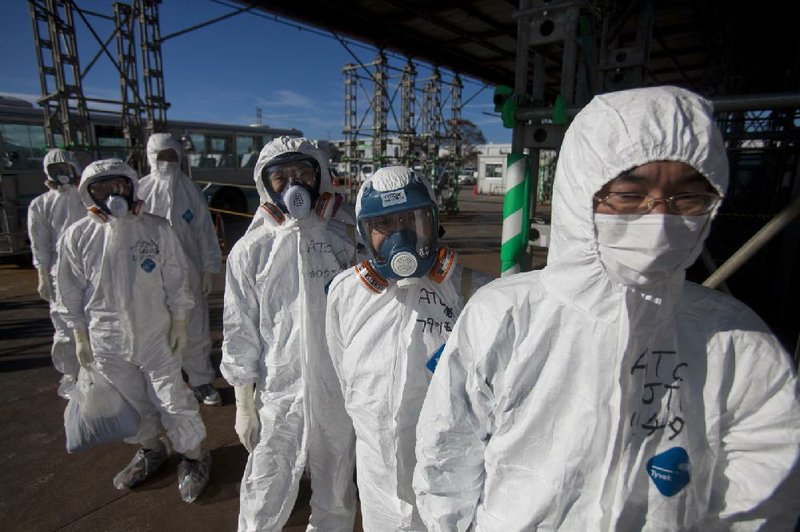TOKYO - Tokyo Electric Power Co., the utility that runs the Fukushima Dai-ichi nuclear plant that melted down in March 2011 after being hit by a tsunami, is struggling to find enough workers to keep the three broken reactors cool while fighting power outages and radiated water leaks, said current and former nuclear plant workers and others familiar with the situation at Fukushima.
Construction jobs are already plentiful in the area due to rebuilding of tsunami-ravaged towns and cities.Other public works spending planned by the government, under stimulus programs backed by Prime Minister Shinzo Abe, is likely to make well-paying construction jobs more abundant.
And less risky, better-paying decontamination projects in the region irradiated by the Fukushima meltdown are another draw.
Some Fukushima veterans are quitting as their cumulative radiation exposure approaches levels risky to health, two long-time Fukushima nuclear workers told The Associated Press. They requested anonymity because speaking to the media is a breach of their employers’ policy, and they would be fired if they are publicly identified.
Hiroyuki Watanabe, a city assemblyman for Iwaki in Fukushima, who talks often to Fukushima Dai-ichi workers, believes the labor shortage is likely to worsen.
“They are scrounging around, barely able to clear the numbers,” he said. “Why would anyone want to work at a nuclear plant, of all places, when other work is available?”
According to Watanabe, a nuclear worker typically earns about $100 a day. In contrast, decontamination work outside the plant, generally involving less exposure to radiation, is paid for by the environment ministry, and with bonuses for working a job officially categorized as dangerous, it totals about $160 a day, he said. TEPCO does not release a pay scale at Fukushima Dai-ichi or provide numbers of workers forced to leave because of radiation exposure.
It does not keep close tabs on contracting arrangements for its workers. A December survey of workers that the company released found 48 percent were from companies not signed as contractors with the utility and the workers were falsely registered under companies that weren’t employing them. It is not clear whether any laws were broken, but the government and TEPCO issued warnings to contractors to correct the situation.
TEPCO spokesman Ryo Shimizu denied any worker shortage and said the decommissioning is progressing.
“We have been able to acquire workers, and there is no shortage. We plan to add workers as needed,” he said.
The discrepancy might stem from the system of contracting prevalent in Japan’s nuclear industry.
Plant operators farm out the running of their facilities to contractors, who in turn find the workers and also rely on lower-level contractors to do some of their work, resulting in as many as five layers of contractors. Utilities such as TEPCO know the final headcount - 3,000 people now at Fukushima Dai-ichi - but not the difficulties in meeting it.
Experts, including even the most optimistic government officials, say decommissioning Fukushima Dai-ichi will take nearly 50 years. TEPCO acknowledges that the exact path to decommissioning remains unclear because an assessment of the state of the melted reactor cores has not yet been carried out.
Since being brought under control following the disaster, the plant has suffered one setback after another.
A dead rat caused a power blackout, including temporarily shutting down reactor cooling systems, and leaks required tons of water to be piped into hundreds of tanks and underground storage areas. The process of permanently shutting down the plant hasn’t gotten started yet, and the work up to now has been one makeshift measure after another to keep the reactors from deteriorating.
Thousands of spent nuclear fuel rods that are outside the reactors also have to be removed and safely stored. Taking them out is complex because the explosions at the plant have destroyed parts of the structure used to move the rods under normal conditions. The process of taking out the rods, one by one, hasn’t even begun yet. The spent rods have been used as fuel for the reactors but remain highly radioactive.
One Fukushima Dai-ichi worker, who has gained a big following on Twitter because of his updates about the state of the plant since the meltdowns, said veteran workers are quitting or being forced to cut back work in highly radiated areas of the plant as their cumulative exposure rises.
“I feel a sense of responsibility to stick with this job,” he said. “But so many people have quit. Their families wanted them to quit. Or they were worried about their children. Or their parents told him to go find another job.”
Known as “Happy-san” to his 71,500 Twitter followers, he has worked in the nuclear industry for 20 years, about half of that at Fukushima. He has worked for bigger contractors before, but he is now at a mid-level contractor with about 20 employees and has an executive-level position.
“If things continue the way they are going, I fear decommissioning in 40 years is impossible. If nuclear plants are built abroad, then Japanese engineers and workers will go abroad. If plants in Japan are restarted, engineers and workers will go to those plants,” he said on Twitter. Most of Japan’s nuclear plants were shut for inspections after the Fukushima disaster.
His cumulative radiation exposure is at more than 300 millisieverts. Medical experts say a rise in cancer and other illnesses is statistically detected at exposure of more than 100 millisieverts, but health damage varies. He was exposed to 60 millisieverts of radiation the first year after the disaster and gets a health checkup every six months.
Nuclear workers generally are limited to 100 millisieverts of exposure over five years and 50 millisieverts in a year, except for the first year after the disaster, when the threshold was raised to an emergency 100 millisieverts.
The workers handle the day-to-day tasks of lugging around hoses, checking valves and temperatures, fixing leaks, moving away debris and working on the construction of the equipment to remove the spent fuel rods.
Other jobs are already so plentiful that securing enough workers for even the more lucrative jobs of decontaminating the towns around the plant is impossible, according to Fukushima Labor Bureau data.
During the first quarter of this year, only 321 jobs were filled from 2,124 openings in decontamination, which involves scraping soil, gathering foliage and scrubbing walls to bring down radiation levels.
“There are lots of jobs because of the reconstruction here,” said bureau official Kosei Kanno.
Watanabe said the bigger nuclear contractors might go out of business because they are being under-bid by lower-tier companies with less experienced, cheaper workers. That is likely to worsen the worker shortages at the skilled level, he said.
Under the worst-case scenario, experienced workers capable of supervising the work will be gone as they reach their radiation exposure limits, said Ryuichi Kino, a free-lance writer and photographer who has written books about the nuclear disaster and has reported on TEPCO since March 2011.
He believes a company independent from TEPCO needs to be set up to deal with the decommissioning, to make sure safety is not compromised and taxpayer money is spent wisely.
Business, Pages 25 on 05/27/2013


